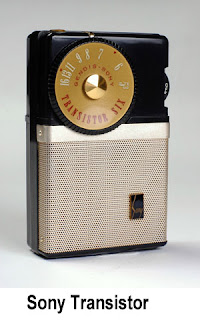In the 1960s, small, portable, and
convenient, transistor radios did not offer excellence in sound quality, but
they did provide another important feature—privacy. In the late 1950s and
through the 1960s, American teenagers saw pocket radios as a way to listen
to the driving beat of rock and roll away
from the judgments of their parents.
The first transistor radio (the Regency TR-1) was produced by Regency Electronics in cooperation with Texas Instruments.
The transistor
radios to the United States by
1959. By the 1960s, transistor radios were even more popular as people became
accustomed to hearing their favorite music, sports, and news wherever they
went.
The
transistor radio might not have had the sound quality of larger table-top
models but it were portable and much cheaper. It was especially appealing to the
young, and became a necessary part of teenage culture in the late 1950s and on
through the 1960s.
Now
that it was no longer necessary to sit still at home to enjoy music, many young
people heard popular songs first on transistor AM radios. Transistor radio
became the major outlet for rock & roll and R&B, and by the 1960s
successful record companies like Motown, and hit-makers like Phil Spector,
were actually mixing their records to suit the low fidelity of these machines
and thereby maximize their appeal to the kids.
Background on the
transistor
The Space program was a major reason for the
development of the transistor. This small device, about the size of a pencil
eraser, replaced heavy, bulky, and unreliable vacuum tubes. This, in turn,
reduced the size and weight of electronic components used in rockets,
satellites, and aircraft.
The invention of the transistor paved the way
for small, mass-produced pocket radios. Transistors also had significantly
lower power usage which meant that batteries became an option as a power
source. The first transistors were used in calculators but were very quickly applied
to radios.







No comments:
Post a Comment